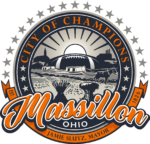The City’s wastewater collection system is a complex network of gravity sewers, sewage-pumping stations and forcemains. The system gathers wastewater from the user, transporting it to trunk sewers then to the interceptor sewers. In turn, these sewers transport the sewage to the Massillon Wastewater Treatment Plant.
Massillon’s wastewater collection system covers an area of more than 19 square miles as well as receives wastewater from Jackson Township and Perry Township, as part of the Stark Metro Sanitary Sewer District. The system includes 169.78 miles of sanitary sewer lines (within the City); 3651 sanitary manholes; 4 pump stations; and 17,475 sanitary sewer service connections (within the City).
Massillon’s wastewater collection system crews are also responsible for maintenance and repair of the sanitary sewer lines and manholes. Additionally, sewer locates are done for other utility work in the public right-of-way. These sewers may be located and painted by our crews. A major component of maintenance of the sewer lines is cleaning. The wastewater collection system and maintenance crews clean all of the 8-inch to 10-in sewer lines at least once every two years. Also the “Trunk” sewer lines, 12-inches to 18-inches, and the interceptor sewer lines, 21-inch to 42-inch, are visually inspected through a four-year period to ensure they are functioning properly.
In addition to the existing system, all new sanitary sewer lines are inspected as they are being installed. After installation the new sewer line and manholes go through a series of testing to ensure that they have been installed properly and that they will provide years of reliable service with minimal maintenance.
Wastewater Collection System Maintenance:
What is seen when city crews are working on the wastewater collection system and what they might be doing.
- Jet/Vac
The jetter uses a high pressure water system to clean the sewer main of debris such as sand, grease and other materials that settle out in the sewer main. Using the high pressure water system (80 gallons per minute at 2,000 psi) the jetter propels a 1-inch hose with a specially designed nozzle at the end up to 500 feet in the sewer main. Once the hose reaches the end, it is pulled back slowly while the high pressure water system is on, flushing the materials to the down stream manhole for removal by the Vactor. The Vac portion of the unit uses a positive displacement to create a vacuum that can lift debris from manholes that are more than 20 ft deep. - Rodding Machine
The Rodding Machine design is to push or pull a specially designed 3/8 in steel rod while rotating in the sewer main. With the use of specially designed tools attached to the end of the rod, this machine is one of the most efficient and dependable methods for removing heavy root growths, sand, grease, and debris from storm, sanitary, and combined sewer pipes. - TV Inspection
As part of our maintenance program we use closed circuit television video (CCTV) inspection equipment and pipeline inspection/asset management software for sanitary and storm sewers. The system uses a self-propelled transporter to carry the camera down the sewer main for a distance of up to 500 ft. While the camera is in operation, all of data is recorded to access maintenance needs. - Manhole Inspection
Manhole inspections are performed on a regular basis throughout the year. It’s main purpose is to quickly verify how the large diameter sewers (8 in through 72 in) are operating. - Locating a sewer main
Almost on a daily basis, someone in the city limits is digging something up. When this happens, the City is required by law to locate and mark its entire infrastructure, which includes the sanitary sewer mains.
Inflow and Infiltration of ground water to the Collection System
Inflow and infiltration is clean water that should not enter the collection system. This water is primarily rain or ground water that is clean and does not require any treatment. Allowing this water to enter the collection system and eventually to the Wastewater Treatment Plant adds unnecessary expenses to the Utilities budget.
PUMP STATIONS
There are four publicly owned pump stations in the wastewater collection system:
The Augusta Lakes Pump Station
The Lincoln Way West Pump Station
The Nova Industrial Park Pump Station
The 17th St/Carmont Pump Station
In addition to the Sanitary Pump stations, the Collection System has several metering stations located in the City.
